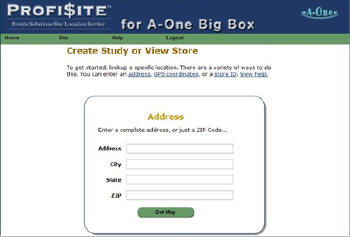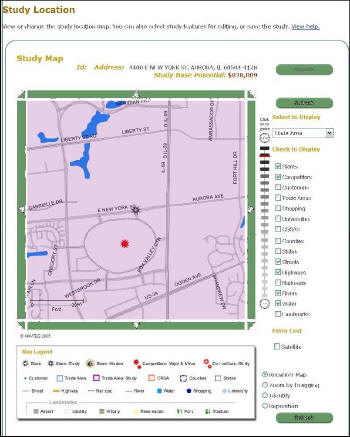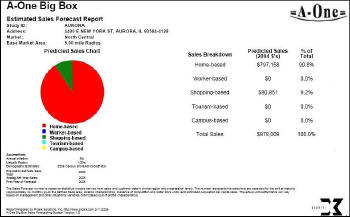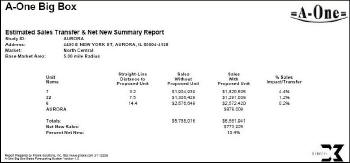 Proxix Solutions Inc.
Proxix Solutions Inc.3202 Palm Harbor Blvd. , Suite A
Palm Harbor, FL 34683
USA
Phone: 727.781.2662
Fax: 727.781.0282
Sales forecasting models are among the most interesting applications of technology in retail development. The models quantify the nature and value of a location, summarize the location’s surrounding market or trade area, and provide a view of the future. A model can create a sense of "insurance" that a given location will perform as expected.
To give you an idea of how specialized these models are, in the U.S and Canada there are perhaps only a dozen experts ("gurus") who create these models. The models use inputs such as site characteristics, demographics, and the nature and market penetration level of both the user’s stores and their competitors’ stores. Some use neural networks, heuristics and the ability to compare a proposed site to other existing locations within the retailers’ network. Comprehensive retail sales forecasting models measure the trade area (customer base) first, and then, the site characteristics second. The test of a given model is how well it assesses the "who and where" of the customer base and how it incorporates the subjectivity of the site quality. Designing and implementing models is complicated and requires an in-depth understanding of market dynamics, which is why there are so few credible model experts.
The Profi$ite approach uses a combination of tested model methodologies and incorporates a proprietary regionalized customer lifestyle database. (See the article titled Dimensions of Data for more on the proprietary database.) The approach applies lifestyle segment differences based on the location of a proposed site. For example, the purchasing patterns of the wealthy (similar income levels, age, etc.) in Chicago are not the same as those in Marin County, CA. This customer “insight” comes from the Proxix database of 110 million households and individual household modeling, which is then applied to the site model. The discrimination detail for the Profi$ite model is based on residential and daytime population densities using 1⁄4 mile grids and applying eight density classes to both the residential and daytime populations. This level of detail provides the ability for an accurate assessment of the potential customer base. The Profi$ite model includes weather and “cultural values” (not generally used by other vendors), accommodates distance to existing stores (for impact assessment), and the distance to competitors stores. Cultural values can most easily be thought of as the diversity that shows up in the local supermarket’s ethnic/specialty food aisle.
After the model assesses the customer base around the proposed location, it then incorporates the site characteristics, which may include:
- Shopping center type (regional, neighborhood, etc.)
- Store type (retailers usually have several sizes and types of stores)
- Time to market (when the store actually comes on line)
- Co-tenancy (what other stores are there and do they have an impact – positive or negative)
- Square footage (many retailers measure sales by sq. ft. of selling space)
- Parking (usually the more parking the better, less parking limits sales)
- Average daily traffic (too little traffic is bad, too much is bad)
- Visibility, access, traffic flow, etc. (the site should be easily visible, have good access and not be hindered by traffic control).
Each model is customized, using both internal and external data to further define the actual customer base. There are always several models developed based on the retail chain’s operational geography. In order to provide wide access for field real estate personnel, the Profi$ite model is Web-based.
The user can identify the site’s location by address, lat/long coordinates or by just clicking on a map. Many proposed locations may not have an address assigned, as they are part of a development that has not yet been built.
The examples below are from a hypothetical store, A-One Big Box. Profi$ite categorizes each project as a “study.” This is because the reports and maps can be used in a site package if the site is determined to be viable for development.
 |
The initial result is a sales forecast for a standard trade area and a map with layers that can be turned off or on. Below is a preliminary sales forecast and map. Note that the preliminary estimated sales are shown at the top of the Study Location dialog. The trade area size can be adjusted using drive-time, radius, or by selecting block groups.
 |
A pull-down menu of choices of how the map can be thematized is in the upper right-hand corner. If desired, each theme can be printed and included in the site package.
 |
There are also several reports available. Below is an example of a report output showing the breakdown of the sources of customers.
 |
 |
All retailers are concerned about the effect a new store might have on their other existing stores. This is a serious issue if the existing stores are franchised and those existing stores could lose sales to the new store. In the A-One Big Box example, the allocation of the impact is shown, along with the net sales gained in the market. In this case, they pick up $773,925 in sales for a market increase of 13.4%. However, the existing stores lose anywhere from 4.4% to .2% of their sales to the new store. Traditionally, an impact of 10% or less is acceptable because the new store adds to the market’s advertising budget and normal market growth will, at the very least, recover those individual stores’ lost sales. In this example, the only concern would be the total investment necessary to pick up $773,925 in sales. Could it be generated by some other means, like better advertising? Or can it be justified by the need to keep a competitor out of the market? These are the kinds of financial and strategic questions that good forecasting models can generate.
Summary
The Profi$ite model has four elements of note. First, the model can be accessed online, so field personnel can get to it from almost anywhere. They can run a “what if analysis” comparing sites while still in the field. Second, the Profi$ite model uses a database of household and lifestyle modeling, including eight population density classes for both residential and daytime populations, and can effectively discriminate both populations down to a 1⁄4 mile grid. Third, it includes weather and cultural values as part of the computations, raising the model’s level of understanding of the marketplace. Fourth, these models are built by a well-known model guru, Brady Foust.
In retail development, all field personnel predict sales as part of the process to justify the investment in the new store. Often these predictions are based purely on experience or “gut feel.” Some of these folks can be both very accurate and very unpleasantly surprised when wrong. The Profi$ite approach of evaluating the market or trade area to understand its viability first helps establish whether there are sufficient customers and of the right type to help decide if the site characteristics are valid. This provides the retailer a documented, consistent and standardized approach to predicting sales. “Gut feel” is always accommodated and sometimes can be more accurate, but a model lets you know how you got to the number.